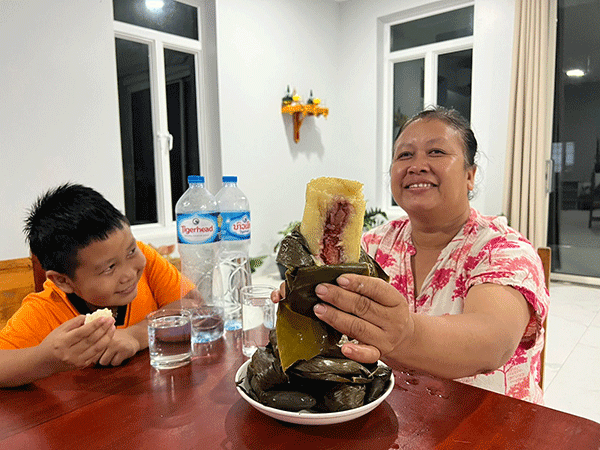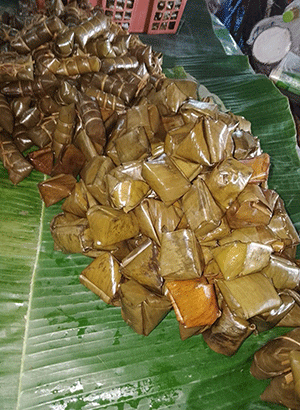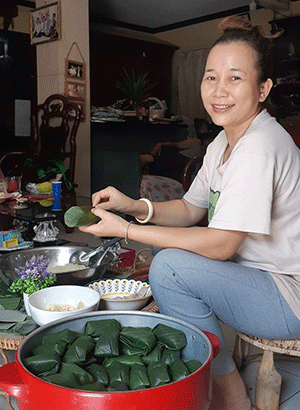Banana leaves the secret to delectable sweet treats
What is your favourite Lao food? Lao people love their food and can cook many kinds of tasty dishes but when entertaining foreigners they sometimes worry that they may not like the taste because Lao food is often spicy and can be difficult to eat.
However, the rice-based snacks khao tom and khao nom always go down a treat as well as generating a lot of interest.
 |
Ms Mone Duangboliboun and her son eat a traditional Lao sweetmeat while talking to the Vientiane Times. |
Khao tom and khao nom are sweetened rice cakes steamed in banana leaf wrappers. They are also a longstanding feature of Lao Buddhist rituals and are often included in the offerings given to temple monks during religious ceremonies.
They are a perennial favourite among Lao people and are especially popular during communal events.
The snacks are made by mixing sticky rice with coconut milk and sugar and then wrapping it in neat banana leaf parcels. Bananas, beans, pork and coconut meat may also be added depending on preference.
Khao nom are packaged in triangular form and khao tom are formed into rectangles. Khao tom is made with sticky rice while khao nom is made with sago.
After being encased in banana leaves, the little packages are steamed or boiled for at least half an hour, but longer is preferable to ensure the contents are cooked right through and become sticky, which makes them more tasty.
If you don’t have banana leaves to hand you can use something else such as pandanus leaves, which give off a fragrant aroma.
Khao tom and khao nom are not commonly on sale in markets, shops and restaurants and must be usually ordered in advance. But at the end of Buddhist Lent (Ork Phansa), which this year occurred on Thursday, they appear in profusion at roadside stalls and markets, just as they have done for centuries.
These snacks were traditionally made at home but today, as people have less time on their hands, they are increasingly purchased from vendors for inclusion in morning almsgiving.
People in rural areas tend to devote more time and energy to the preparation of these sweetmeats than their urban cousins, but it wasn’t always so. Everyone used to make the festive foodstuffs themselves – just enough for the family and a few monks – and rice cakes were never seen in markets.
 |
Khao nom. |
 |
A woman makes khao tom and khao nom, popular home-made snacks. |
Ms Mone Duangboliboun from Phongerm village in Hadxaifong district, Vientiane, told the Vientiane Times that making rice cakes was a lot of fun, especially for young people, “When I was teenager, the end of Buddhist Lent was always a fun time because there were so many activities we could take part in, especially preparing food for Buddhist rituals.”
The day before Ork Phansa, in the early morning, people would collect banana leaves and dry them in the sun to toughen them or, if the weather was cool, they’d steam the leaves so they wouldn’t break when wrapping the rice,” Mone recalled.
In the early evening young people would gather in groups and visit each other’s houses to make the rice cakes. It was a good opportunity for young men and women to get acquainted, and no doubt many romances began this way. Shyness (and proper manners) prevailed in those days; you couldn’t come right out and profess your attraction to someone of the opposite sex.
A favourite trick among the girls, says Mone, was to mix chillies into some of the rice, which they hoped would teach a lesson to the guys they didn’t fancy who might come to woo them later that night. It was common for the boys to wash up after their days’ chores and visit the girls’ homes in groups to eat together.
There was no way of knowing who’d get the spicy rice cakes, though, because the girls would mix them up together in the same bowl.
“We’d ask the guys if our rice cakes were good, and basically everyone said yes, so we sometimes didn’t know who got the spicy ones. But usually we could see by the look on their face or if they’d suddenly call out for water!”
Since the rice cakes were all mixed together, it wasn’t the best way to fend off unwanted attention, Mone admits. “Adding chilli to the rice didn’t necessarily mean there were some boys we didn’t like – we did it mostly just for fun, so the guys never got angry with us. But we did have to be careful not to take any chilli cakes to the temple!”
Of course, nowadays young people indulge in other forms of courtship and use different ways to tease each other. Few would be interested in making rice cakes together, and anyway they can easily be bought in a market. Meanwhile older people, especially those living in towns, are too busy to make their own holiday treats.
Vendors produce a variety of textures and styles of rice cakes, but a lot of people are like Mone, missing an old-fashioned annual routine that brought so much joy. “Every Ork Phansa reminds me of what my friends and family used to do in the past,” she said.
“There was a strong sense of community spirit because people always helped each other, no matter what we were doing.”
Buying rice cakes might be cheaper, she says, but the camaraderie involved in making your own together with friends was priceless.
By Patithin Phetmeuangphuan
(Latest Update October 15, 2024)
|




